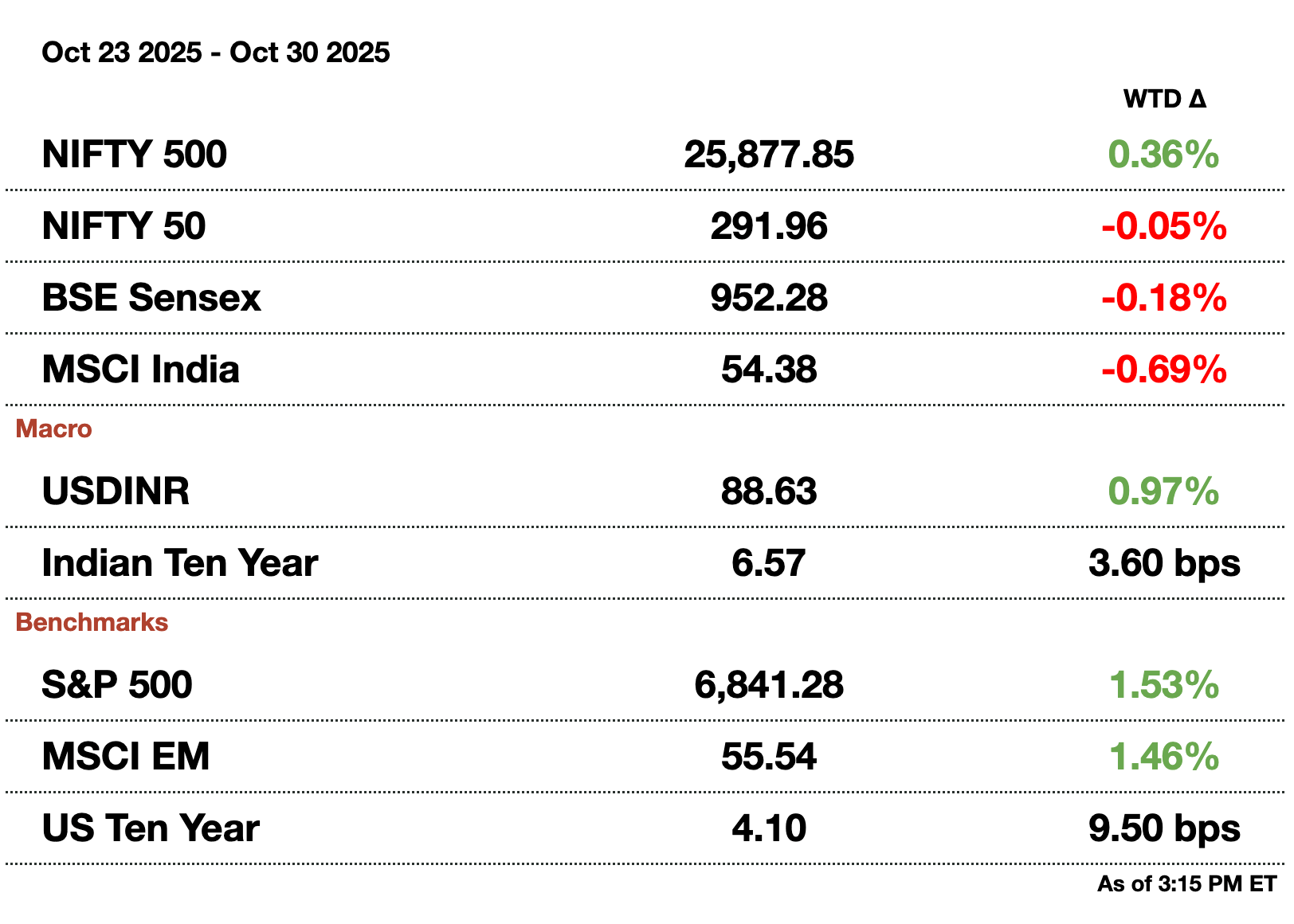- Samosa Capital
- Posts
- 📰Rupee Nears Record Low | Daily India Briefing
📰Rupee Nears Record Low | Daily India Briefing
Three stories on Indian markets that you can't miss.


Today’s deep dives: The Indian rupee fell to nearly a record low after the Fed cut rates. Three of India’s largest refiners have suspended purchases of Russian oil. One of India’s largest asset managers is optimistic on corporate earnings.
We want to talk to you! Just respond to this email and we’ll set up a time to learn more about how Samosa Capital can be more helpful in your work.
If you have any questions about India, fill out this form or reach out to Shreyas at [email protected]



Macro
LT Foods’ quarterly profit jumps 18% on strong Indian demand and cheaper crops. LT Foods, the maker of Daawat rice, reported an 18% rise in profit to $26 million (₹2.31 billion) for the July–September quarter. The gain came from higher domestic sales and lower raw material costs.
India to impose 30% import duty on yellow peas starting November 1. The Indian government said it will reintroduce a 30% import duty on yellow peas to protect domestic farmers as the harvest season begins.
Global gold demand hits record $84 billion (₹7.44 trillion) in Q3, WGC says. Global gold demand rose 3% in Q3 to a record $84 billion (₹7.44 trillion), fueled by surging investor buying amid geopolitical uncertainty, according to the World Gold Council.
Equities
NTPC’s quarterly profit rises 9% as expenses fall. State-run power producer NTPC reported a 9% increase in quarterly profit to $1.08 billion (₹95.8 billion) for July–September. The rise was driven by lower fuel and operating costs despite a modest dip in revenue.
Reliance Jio to give users 18 months of free access to Google’s Gemini AI Pro. Reliance Jio customers will get complimentary access to Google’s Gemini AI Pro for 18 months, part of a partnership to expand AI use in India’s digital ecosystem.
Toyota boosts India focus with new SUVs, rural push as profit jumps 47%. Toyota said quarterly profit surged 47% to $9.2 billion (₹816 billion), driven by strong sales in India and other Asian markets, where it plans new SUV launches and rural expansion.
Alts
India’s market regulator suspends Gretex Merchant Banking for 21 days. SEBI banned Gretex from taking new merchant banking deals for 21 days after finding irregularities in Jayant Infratech’s IPO. The firm failed to properly verify disclosures and allowed nearly 40% of the IPO funds to go toward an incomplete office project.
Air India Express plans to double capacity within five years. The budget airline owned by Tata Group said it aims to double its fleet and route network in four to five years. The expansion will focus on growing short-haul international and domestic operations.
Cyclone Montha causes $603 million (₹53.5 billion) in damages, Indian state says. The eastern Indian state of Odisha estimated losses from Cyclone Montha at about $603 million (₹53.5 billion), mostly from destroyed homes, crops, and infrastructure.
Cipla’s quarterly profit beats estimates on strong respiratory drug demand. Drugmaker Cipla reported profit above expectations at $157 million (₹13.9 billion) for July–September, driven by steady demand for its respiratory products.
Swiggy narrows quarterly loss as quick-commerce sales grow. Swiggy cut its quarterly loss to $54 million (₹4.8 billion), with strong growth in its quick-delivery business offsetting weakness in restaurant orders.
DP World pledges $5 billion (₹443 billion) for Indian infrastructure. Dubai-based logistics firm DP World announced plans to invest $5 billion (₹443 billion) in India’s ports, logistics, and renewable energy sectors over the next few years.
Policy
India issues licenses to companies importing rare earth magnets from China. The Indian government said several firms have now been licensed to import rare earth magnets from China, following earlier curbs on such imports.
India’s defence minister to meet U.S. counterpart and Malaysia officials. Defence Minister Rajnath Singh will meet U.S. Defence Secretary Pete Hegseth and Malaysian officials next week. The talks will focus on expanding defence cooperation and regional security ties.India’s market regulator approves Nifty Bank index overhaul by March 2026. SEBI has allowed the Nifty Bank index to be restructured by March 2026, marking its first major revision in years. The change will update index eligibility rules to better reflect India’s evolving banking landscape.
U.S. grants India six-month sanctions waiver for Chabahar port deal. Washington approved a six-month exemption allowing India to continue operations at Iran’s Chabahar Port, which is key to its trade route to Afghanistan and Central Asia.

How High-Net-Worth Families Invest Beyond the Balance Sheet
Every year, Long Angle surveys its private member community — entrepreneurs, executives, and investors with portfolios from $5M to $100M — to understand how they allocate their time, money, and trust.
The 2025 High-Net-Worth Professional Services Report reveals what today’s wealthy families value most, what disappoints them, and where satisfaction truly comes from.
From wealth management to wellness, from private schools to personal trainers — this study uncovers how the top 1% make choices that reflect their real priorities. You’ll see which services bring the greatest satisfaction, which feel merely transactional, and how spending patterns reveal what matters most to affluent households.
Benchmark your household’s service spending against peers with $5–25M portfolios.
Learn why emotional well-being often outranks financial optimization.
See which services families are most likely to change — and which they’ll never give up.
Understand generational differences shaping how the wealthy live, work, and parent.
See how your spending, satisfaction, and priorities compare to your peers. Download the report here.
Reach out to [email protected] to reach our audience and see your advertisement here.

1. Rupee Nears Record Low as Fed Strengthens Dollar

The Indian rupee tumbled close to a record low on Thursday, pressured by a resurgent U.S. dollar after the Federal Reserve signaled it may delay rate cuts, prompting traders to unwind bets on easier policy in December.
The currency fell as much as 0.6% to ₹88.74 per dollar, nearing its September record of ₹88.81 — the weakest level ever. Dealers said the RBI, which had previously intervened to defend the rupee, appeared less active in the spot market, allowing the currency to adjust more freely.
“Most Asian currencies have weakened after the Fed’s comments, but the rupee has taken a bigger hit in the absence of strong RBI dollar sales,” said Anil Kumar Bhansali of Finrex Treasury Advisors. Market participants also cited dollar demand linked to the RBI’s unwinding of non-deliverable forward positions, which further weighed on sentiment.
Analysts now see ₹89.50–₹90 as the next key threshold if the rupee breaches its previous low. A sustained slide could raise import costs and pressure India’s bond market, which has recently seen strong foreign inflows.
Economists suggest the RBI’s restraint is strategic — allowing the rupee to act as an “automatic stabilizer” amid global turbulence. “The RBI may be letting the currency absorb the external shock rather than burning reserves,” said Madhavi Arora of Emkay Global.
Still, with the Fed’s hawkish tone and limited central bank defense, traders warn the rupee could soon enter uncharted territory.
2. Three of India’s Largest Refiners Stop Buying Russian Oil

Three of India’s largest refiners, Reliance Industries, Mangalore Refinery and Petrochemicals, and HPCL-Mittal Energy, have suspended purchases of Russian crude for the coming months, signaling the sharpest pullback in Moscow-bound energy flows since the Ukraine war began.
The move follows Washington’s decision to blacklist Rosneft PJSC and Lukoil PJSC, Russia’s two biggest producers, effectively cutting off payment and logistics channels for their oil. Combined, the three refiners accounted for over 50% of India’s Russian crude imports, or roughly 920,000 barrels per day in the first half of 2025.
Reliance, previously Russia’s top Indian client under a long-term Rosneft deal, has now shifted to Middle Eastern and U.S. grades, recently snapping up 10 million barrels of replacement cargoes. MRPL and HPCL-Mittal have paused all spot purchases, citing the risk of secondary U.S. sanctions that could limit access to global finance.
While Indian Oil Corp. (IOC) has pledged to maintain Russian imports “in compliance with sanctions,” it has simultaneously sought 24 million barrels from the Americas, signaling a broader pivot in sourcing. Bharat Petroleum has also shown interest in smaller Russian deals but remains cautious.
The pause underscores India’s delicate balancing act — preserving cheap energy access without provoking Western penalties. As New Delhi weighs its next move, refiners’ diversification efforts highlight the growing geopolitical costs of its oil dependence on Moscow.
3. Axis Mutual Fund Sees Earnings Downgrades Bottoming Out

Mumbai
IAxis Mutual Fund, one of India’s largest asset managers with $40 billion in assets, believes the tide may finally be turning for corporate earnings. After four consecutive quarters of analyst downgrades, the fund’s Chief Investment Officer Ashish Gupta says the worst appears to be over, signaling potential stabilization for Indian equities.
“The downgrade cycle is now primarily behind us,” Gupta said, noting that the ongoing earnings season has been mixed but more resilient than feared. The Nifty 50 Index has gained over 5% in October, marking its best month since March, driven by expectations of a recovery in consumption and lending.
Axis expects multiple catalysts to lift profits across key sectors. A potential easing of central bank lending restrictions could boost credit growth and support banks, while possible GST cuts on consumption goods and automobiles may spark demand. Together, these two sectors make up roughly half of the Nifty’s market capitalization.
Still, Gupta cautioned that high valuations, at 21x forward earnings vs. a 10-year average of 18x, may limit short-term upside, particularly as a surge in IPO activity adds share supply. Consensus forecasts call for 9–10% earnings growth this fiscal year, rising to 17% in FY27, with profits becoming “much more broad-based.”
If earnings stabilize as expected, India could regain its position as one of the most attractive equity markets in the emerging world.
How helpful was today's newsletter? |
See you tomorrow.
Written by Eshaan Chanda & Yash Tibrewal. Edited by Shreyas Sinha.
Sponsor the next newsletter to reach tens of thousands of U.S.-based business-savvy professionals. Reach out to [email protected].
Could your business use expert insights to power growth in India? Reach out to [email protected] for a free introductory call.
Disclaimer: This is not financial advice or recommendation for any investment. The Content is for informational purposes only, you should not construe any such information or other material as legal, tax, investment, financial, or other advice.

